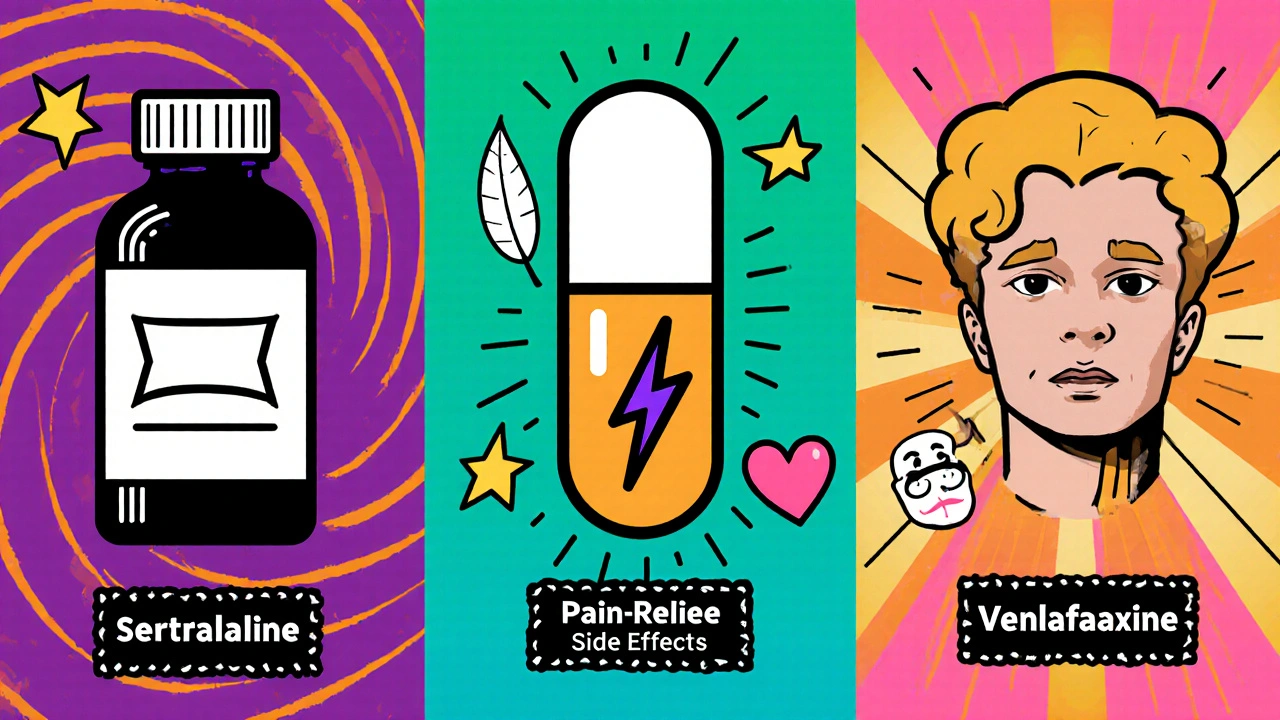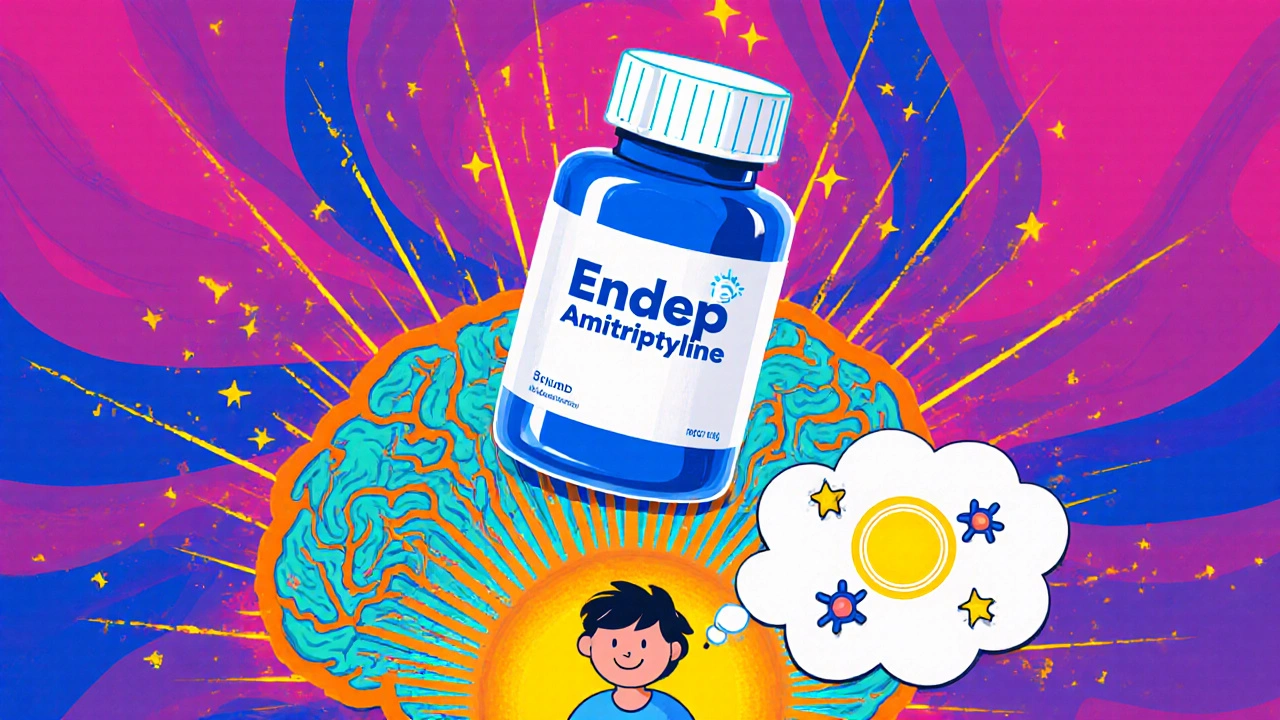18 Oct 2025
- 8 Comments
When you hear the name Endep (Amitriptyline) is a tricyclic antidepressant (TCA) used for depression, anxiety, and certain types of chronic pain. It’s been around since the 1960s, but newer drugs have crowded the market. If you’re weighing Endep against other options, you’ll want to compare how they work, how quickly they act, side‑effect profiles, and how easy they are to take.
Why a Comparison Matters
Choosing the right antidepressant isn’t a one‑size‑fits‑all decision. Genetics, other health conditions, and even lifestyle can tip the scales. A clear side‑by‑side view helps you and your clinician decide whether Endep’s benefits outweigh its drawbacks or if an alternative fits better.
Key Takeaways
- Endep works by boosting norepinephrine and serotonin but can cause dry mouth, constipation, and weight gain.
- SSRIs (e.g., sertraline, escitalopram) are usually first‑line because they have fewer anticholinergic effects.
- SNRIs (e.g., venlafaxine) offer a middle ground: stronger pain relief than SSRIs with fewer TCA side effects.
- Mirtazapine and bupropion provide distinct mechanisms that can help when SSRIs fail.
- Nortriptyline, a TCA like Endep, is often preferred for patients who need a more predictable side‑effect profile.
How Endep (Amitriptyline) Works
Amitriptyline blocks the reuptake of norepinephrine and serotonin, increasing their levels in the brain. It also has strong antihistamine and anticholinergic activity, which accounts for sedation and the classic "dry‑mouth" feeling.
Typical starting dose for depression is 25 mg at bedtime, gradually titrated up to 150 mg per day. For chronic pain, doctors often start at 10 mg at night and may go as high as 100 mg.
Common Alternatives and How They Differ
| Drug | Class | Typical Daily Dose | Onset of Mood Improvement | Common Side Effects | Pros | Cons |
|---|---|---|---|---|---|---|
| Endep (Amitriptyline) | Tricyclic Antidepressant | 25-150 mg | 2-4 weeks | Dry mouth, constipation, weight gain, sedation | Effective for pain, low cost | Anticholinergic burden, overdose risk |
| Sertraline | SSRI | 50-200 mg | 1-2 weeks | GI upset, sexual dysfunction, insomnia | Well‑tolerated, safe in overdose | May cause activating anxiety early on |
| Escitalopram | SSRI | 10-20 mg | 1-2 weeks | Nausea, fatigue, sexual side effects | High efficacy, minimal drug interactions | Cost higher than generic SSRIs |
| Venlafaxine | SNRI | 75-225 mg | 2-3 weeks | Elevated blood pressure, nausea, sweating | Good for mixed anxiety‑depression, pain relief | Blood pressure monitoring needed |
| Mirtazapine | NaSSA | 15-45 mg | 1-2 weeks | Weight gain, sedation, increased appetite | Rapid sleep aid, helpful when appetite low | Weight gain can be problematic |
| Bupropion | NDRI | 150-300 mg | 2-4 weeks | Dry mouth, insomnia, tremor | Low sexual side‑effect risk, good for smoking cessation | Seizure risk at high doses |
| Nortriptyline | Tricyclic Antidepressant | 25-150 mg | 2-4 weeks | Less anticholinergic than amitriptyline, dry mouth, dizziness | More tolerable TCA option, useful for neuropathic pain | Still carries TCA‑class risks |

When Endep Might Be the Right Choice
- Chronic Pain Management - Its analgesic properties are useful for migraine, fibromyalgia, and neuropathic pain.
- Cost Sensitivity - As a generic, it’s cheaper than most newer agents.
- Sleep Issues - The sedating effect can help patients with insomnia who also need an antidepressant.
If any of these align with your health goals, Endep could be a solid pick, provided you can tolerate its side‑effect profile.
When to Consider an Alternative
Switch if you experience any of the following:
- Persistent dry mouth or constipation that interferes with daily life.
- Significant weight gain or increased appetite.
- Cardiac concerns - TCAs can affect heart rhythm, especially in older adults.
- Risk of overdose - TCAs are lethal in much lower doses than SSRIs.
In such cases, an SSRI like sertraline or an SNRI like venlafaxine often provides similar mood benefits with a cleaner side‑effect slate.
Practical Tips for Switching or Starting
- Gradual Taper - Reduce Endep by 10‑25 mg every 1‑2 weeks to avoid withdrawal.
- Cross‑taper - Introduce the new drug at a low dose while you taper Endep.
- Monitoring - Check blood pressure if starting venlafaxine; watch for serotonin syndrome if combining serotonergic agents.
- Lifestyle - Stay hydrated, eat fiber‑rich foods, and consider a saliva substitute for dry mouth.

Potential Drug Interactions to Watch
Endep’s metabolism involves CYP2D6 and CYP2C19. Drugs that inhibit these enzymes (e.g., fluoxetine, paroxetine) can raise amitriptyline levels, increasing toxicity risk.
Other high‑risk combos include:
- MAO inhibitors - must wait at least 14 days after stopping either drug.
- QT‑prolonging agents (e.g., certain antipsychotics) - monitor ECG.
- Alcohol - amplifies sedation and dizziness.
Special Populations
Elderly: Start at 10 mg nightly; avoid high doses because of falls risk.
Pregnant or breastfeeding: TCAs cross the placenta; discuss risks with your OB‑GYN. Generally, SSRIs are preferred.
Kids and adolescents: Use only when benefits clearly outweigh risks; monitor for increased suicidal thoughts.
Bottom Line
Endep remains a versatile agent, especially when pain relief and sleep aid are priorities. However, its anticholinergic side effects and safety concerns push many clinicians toward newer agents for pure depression treatment. Weighing the pros and cons side‑by‑side-like in the table above-gives you a clearer picture of which medication aligns with your health needs.
Frequently Asked Questions
Can I take Endep for anxiety?
Yes, many doctors prescribe amitriptyline for generalized anxiety or panic disorder, especially when the patient also experiences insomnia or chronic pain.
How long does it take for Endep to start working?
Most people notice mood improvement after 2‑4 weeks, but the full therapeutic effect can take up to 8 weeks.
Is Endep safe to use with alcohol?
Mixing alcohol with amitriptyline can increase drowsiness, dizziness, and the risk of overdose. It’s best to avoid or limit alcohol while on this medication.
What are the signs of amitriptyline overdose?
Symptoms include rapid heart rate, low blood pressure, seizures, severe confusion, and coma. Seek emergency care immediately if you suspect an overdose.
Can I switch from Endep to an SSRI without a washout period?
Because both drugs affect serotonin, a short cross‑taper is usually recommended rather than a full washout. Your doctor will taper Endep while introducing the SSRI at a low dose.


Brian Van Horne
October 18, 2025Endep stands as a venerable, cost‑effective workhorse in the antidepressant arena; its efficacy in pain and insomnia is undeniable, yet the anticholinergic side‑effects demand careful consideration.
Norman Adams
October 18, 2025Ah, the timeless glamour of amitriptyline-nothing says “I’m sophisticated” quite like a medication that doubles as a potential cardiac hazard. One might as well wear a monocle while battling dry mouth and constipation, don’t you think?
Margaret pope
October 18, 2025Folks remember that starting low and titrating slowly can really smooth the ride for anyone trying Endep especially if you keep hydrated and add some fiber to your diet
Karla Johnson
October 18, 2025When evaluating Endep versus newer agents, it is essential to first acknowledge the drug's dual utility in mood regulation and nociceptive modulation, which sets it apart from many SSRIs that lack analgesic properties.
Moreover, the pharmacodynamic profile of amitriptyline-characterized by potent inhibition of norepinephrine and serotonin reuptake alongside significant antihistaminic and anticholinergic activity-contributes both to its therapeutic benefits and its side‑effect burden.
From a clinical standpoint, the sedative effect can be advantageous for patients suffering from insomnia, but that same sedation may impair daytime functioning if dosed inappropriately.
The anticholinergic load, manifesting as dry mouth, constipation, and potential cognitive blunting, warrants vigilant monitoring, particularly in older adults where the risk of falls and confusion escalates.
Financial considerations also play a role: Endep remains inexpensive, an attractive attribute for individuals without comprehensive insurance coverage.
Nevertheless, the narrow therapeutic index and the heightened lethality in overdose situations differentiate it from SSRIs, which possess a considerably safer overdose profile.
Switching strategies should involve a gradual taper-often 10‑25 mg decrements every one to two weeks-to mitigate withdrawal phenomena such as vivid dreams or rebound insomnia.
Cross‑tapering to an SSRI or SNRI can be accomplished by introducing the new agent at a low dose while maintaining a reduced Endep dose, thereby smoothing the serotonergic transition and lessening the risk of serotonin syndrome.
Clinicians must also assess drug‑drug interactions, especially inhibitors of CYP2D6 and CYP2C19 like fluoxetine, which can elevate amitriptyline plasma concentrations and precipitate toxicity.
Blood pressure monitoring becomes pertinent when considering venlafaxine as an alternative, given its propensity to raise systolic pressures at higher doses.
In populations such as the elderly, initiating therapy at 10 mg nightly is prudent to balance efficacy with tolerability, and avoiding high dose escalation can reduce fall risk.
Pregnant patients generally favor SSRIs due to the teratogenic profile of TCAs, yet the decision must be individualized after thorough risk‑benefit analysis.
Ultimately, the choice hinges on whether the patient prioritizes analgesia and sleep aid over a cleaner side‑effect slate; shared decision‑making with the patient ensures alignment with their values and health goals.
In summary, Endep remains a versatile option, but its side‑effect profile necessitates careful patient selection and diligent monitoring.
Linda A
October 19, 2025The melancholy of a TCA beats the sterile hum of a modern SSRI.
Emma Williams
October 19, 2025Let’s all remember that a gentle taper and good hydration can make Endep workable for many, and sharing tips about fibre intake can help everyone.
Stephanie Zaragoza
October 19, 2025While Endep offers undeniable analgesic benefits, the clinician must weigh its anticholinergic burden-dry mouth, constipation, weight gain-against patient comorbidities; therefore, a thorough review of cardiac history, concomitant CYP2D6 inhibitors, and overdose risk is indispensable, especially in populations with limited monitoring capabilities.
James Mali
October 19, 2025Endep works but… 😑